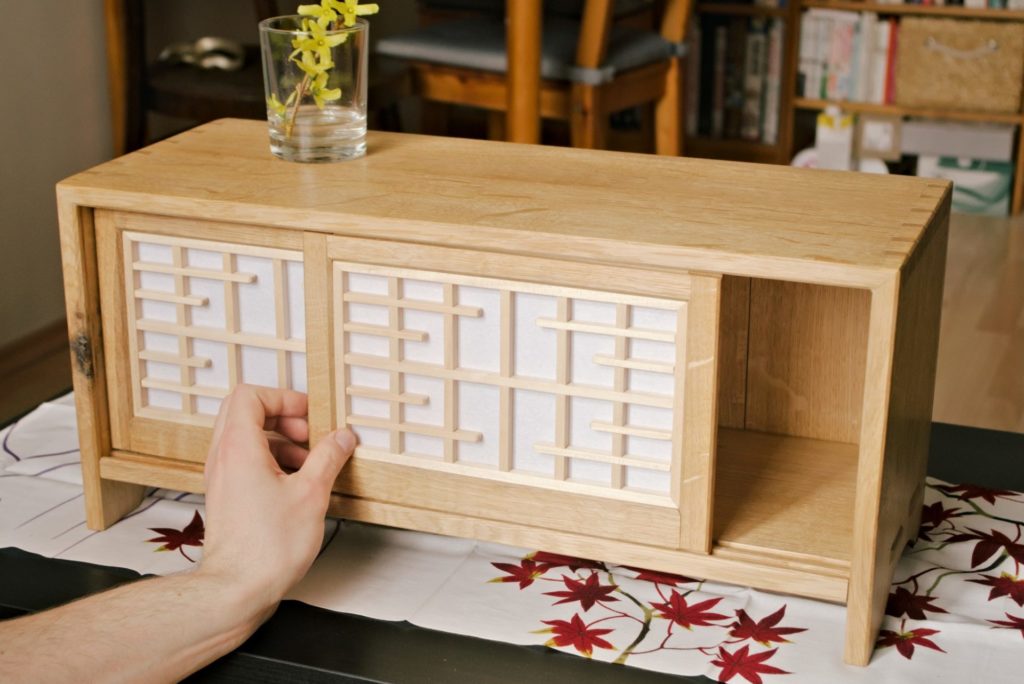One of the typical elements of the japanese home are the Shoji sliding doors「障子」with the Kumiko lattice panel「組子」covered by rice paper, which softens the light shining through. Everyone, who either had been in Japan or at least had seen a japanese movie, has surely encluntered the Shoji with its characteristic presence. But the Shoji doesn't have to be only a large door in a house, but it can also be used as a small sliding door in furniture, as is the case in the oaken cabinet, which you can see on the photographs. Eastern aesthetics can thus find its way even into a western home.


One truly doesn't have to worry about combining these two aesthetical approaches, since the japanese furniture has a unique minimalistic quality and can easily fit into any environment. The key elements of japanese furniture are simple shapes, sophisticated craftsmanship in details and natural beauty of wood, all of which create a unique sense of quiet elegance.
This small oaken cabinet may serve for storage of various object ranging from precious chinaware, books or even music CDs. Thanks to the sliding doors, the inside is covered and protected from dust. The Shoji slides in grooves, which are waxed for smoother movement. The ends of the grooves are, however, intentionally slightly tapered, so that the doors close firmly. On top of it, either or both Shoji can be easily removed, should you wish to use the cabinet without them.

Traditionally, the panel of the Shoji sliding door consists of a Kumiko lattice formed into a certain pattern. The variety of these Kumiko patterns is enormous, starting with plain rectangular grids, all the way to intricate formations evoking natural motifs and sceneries made of hundreds or thounds of Kumiko pieces.
Pro tuto dubovou skříňku jsem zvolil poměrně prostý, ale přesto elegantní kumiko motiv „Kasumi,“ což v japonštině znamená mlha. The different lengths of the horizontal pieces create a sense of a slowly dissipating mist, revealing a distant ladnscape beyond. Although the individual Kumiko pieces are quite thin - some only 4 milimeters - the whole grid is surprisingly rigid due to the interconnected joints and there is no need to worry about damaging it. The Kumiko lattices are connected by halp-lap joints and each one also slides with tenons into small mortices of the doors. The resulting assembly is strong enough, that no glue is necessary.
While the body of the cabinet is made from oak wood, for the Kumiko panel I have chosen linden wood, which thanks to its lighter colour creates a pleasent contrast with the honey-like hue of oak. The second contrasting element is a pair of maple butterfly key inlays in the left part of the shelf, which reinforce two splits around knots. However, these defects weren't serious enough to prevent using the wood, and so I've decided to repair them like this and make them into a decorative visual component.
The structure of the cabinet is completely self-locking and it's designed, so that it can be assembled only in a certain sequence. In tandem with precisely cut joinery, there is no need for glue or other fasteners. The top of the cabinet is joined to the sides with dovetails, while the lower shelf has through tenons on either sides, which serve a structural as well as decorative purpose.
The cabinet body is comprised of a single long piece of oak wood, and so the wood grain runs seamlessly aroud the cabinet. For the Shoji door on the other hand, I have carefully chosen the wood, so that the wood grain is converging in a slight inner curve, which helps creating a sense of the rectangular door's frame closing on itself. Last but not least, stojí za zmínku ještě jedna zvláštnost tohoto rámu šódži, a tou je tradiční japonské zakončení „džaguči,“ that you can see on the photograph. The Jaguchi in this case means, that on the outer side of the rails of the doors there are 3 milimeters long extending miters, that perfectly match the chamfer on the stiles. When the two pieces are joined together, it creates a very elegant connection. Details such as this, are the key difference, that distinguish hand craftsmanship from serially manfucatured furniture.
All surfaces of this cabinet are handplaned to smoothness and then finished with three coats of natural shellac. The most strained areas are also waxed for increased resilience and easier movement of the sliding doors. The Kumiko panel of the Shoji are the only parts, that aren't finished with any coating, to preserve the light hue of the linden wood. Nonetheless, the handplaned finish is more than enough protection.
Despite its small size, this oaken cabinet incorporates several distinct features of the Japanese aesthetics and I hope, that it will serve as an illustration of the unique magic of Japanese furniture. For the Shoji sliding door, instead of a Kumiko panel and its vast array of patterns, one could use a glass panel or wooden insert. If you would be interested, we can arrange creating a one of a kind furniture excatly to your desire and needs, be it a small piece like this or a grand wardrobe. Don't hesitate to contact me with any questions or requests.














Had to share that I stumbled on this project while looking for inspiration for my own attempt at a sliding shoji doors. I loved it so much I straight up copied it. Thanks so much for sharing.
https://www.reddit.com/r/woodworking/comments/1csp30b/inspired_by_shogun_i_took_a_swing_at_a_little/
Nice work, Isaac! I am glad, that you liked my design and I could provide some inspiration. It will surely be a beautiful addition to your household!
Best regards from the Czech Republic!
Tomáš Marvan
Tomiki